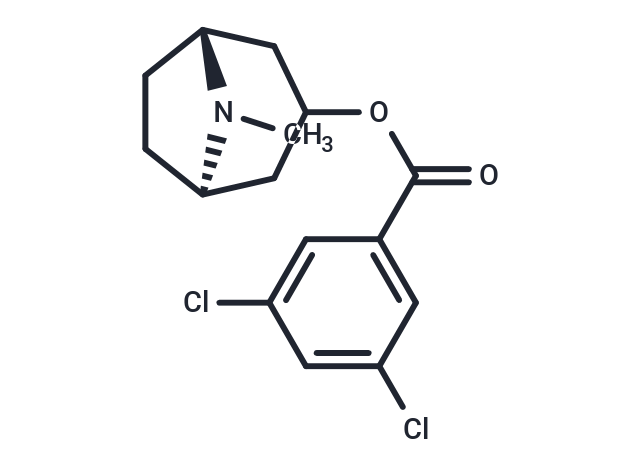Shopping Cart
- Remove All
 Your shopping cart is currently empty
Your shopping cart is currently empty

Bemesetron (MDL 72222) is a selective 5-HT3 antagonist (IC50 = 0.33 nM) that exhibits neuroprotective effects.

| Pack Size | Price | Availability | Quantity |
|---|---|---|---|
| 10 mg | $50 | In Stock | |
| 25 mg | $64 | In Stock | |
| 50 mg | $86 | In Stock |
| Description | Bemesetron (MDL 72222) is a selective 5-HT3 antagonist (IC50 = 0.33 nM) that exhibits neuroprotective effects. |
| Targets&IC50 | 5-HT3 receptor:0.33 nM |
| In vitro | In primary cortical neuronal cells, Bemesetron (1 μM) significantly blocks the H2O2-induced increase of caspase-3 immunoreactivity. Bemesetron (0.01, 0.1 and 1 μM) and Y25130 (0.05, 0.5 and 5 μM) concentration-dependently reduce the H2O2-induced decrease showing inhibition of 74.9 and 79.0% with 1 μM and 5 μM, respectively[2]. |
| In vivo | In male adult albino mice, Bemesetron (1 mg/kg; i.p.) causes a significant reduction of catalepsy, while Bemesetron (10 mg/kg; i.p.) significantly potentiates the phenomenon. The maximum inhibition of catalepsy (about 75%) occurs at 120 min, and the maximum potentiation (about 4.5-times the control value) occurs at 60 min after Haloperidol[3]. |
| Alias | TROPANYL 3,5-DICHLOROBENZOATE, MDL 72222, 3-TROPANYL-3,5-DICHLOROBENZOATE |
| Molecular Weight | 314.21 |
| Formula | C15H17Cl2NO2 |
| Cas No. | 40796-97-2 |
| Smiles | CN1[C@@H]2CC[C@@H]1CC(C2)OC(=O)c1cc(Cl)cc(Cl)c1 |
| Relative Density. | 1.34 g/cm3 (Predicted) |
| Storage | Powder: -20°C for 3 years | In solvent: -80°C for 1 year | Shipping with blue ice. | |||||||||||||||
| Solubility Information | DMSO: 2 mg/mL (6.37 mM), Sonication is recommended. | |||||||||||||||
Solution Preparation Table | ||||||||||||||||
DMSO
| ||||||||||||||||

Copyright © 2015-2024 TargetMol Chemicals Inc. All Rights Reserved.